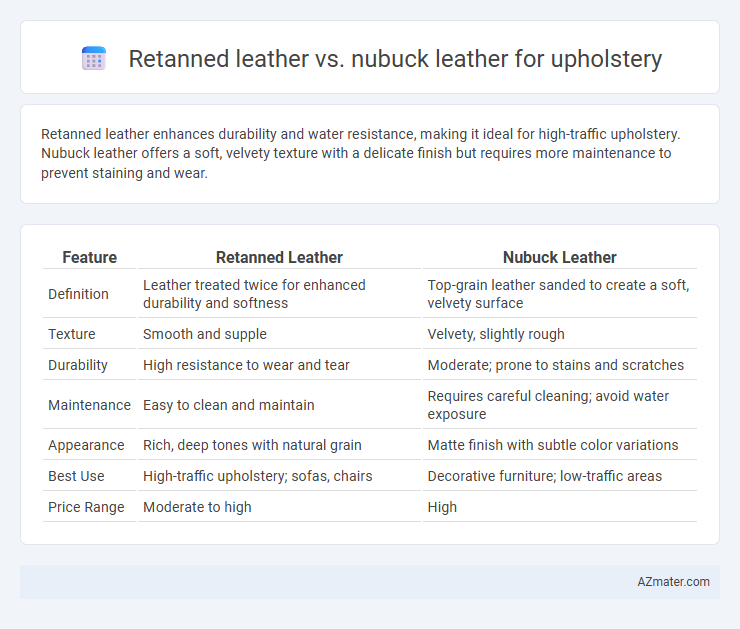Retanned leather enhances durability and water resistance, making it ideal for high-traffic upholstery. Nubuck leather offers a soft, velvety texture with a delicate finish but requires more maintenance to prevent staining and wear.
Table of Comparison
| Feature | Retanned Leather | Nubuck Leather |
|---|---|---|
| Definition | Leather treated twice for enhanced durability and softness | Top-grain leather sanded to create a soft, velvety surface |
| Texture | Smooth and supple | Velvety, slightly rough |
| Durability | High resistance to wear and tear | Moderate; prone to stains and scratches |
| Maintenance | Easy to clean and maintain | Requires careful cleaning; avoid water exposure |
| Appearance | Rich, deep tones with natural grain | Matte finish with subtle color variations |
| Best Use | High-traffic upholstery; sofas, chairs | Decorative furniture; low-traffic areas |
| Price Range | Moderate to high | High |
Introduction to Retanned and Nubuck Leather
Retanned leather undergoes a secondary tanning process that enhances durability and imparts a refined finish, making it ideal for upholstery requiring long-lasting wear resistance. Nubuck leather is crafted from the outer side of a hide, sanded to create a soft, velvety surface prized for its luxurious texture and aesthetic appeal in furniture design. Both materials offer unique qualities: retanned leather excels in toughness and maintenance, while nubuck provides a premium look with a delicate, textured feel.
What Is Retanned Leather?
Retanned leather is a type of leather that undergoes a secondary tanning process using a variety of tannins or chemicals to enhance durability, softness, and colorfastness, making it ideal for upholstery. This method improves resistance to wear, water, and fading, providing a robust material suited for high-traffic furniture applications. Unlike nubuck leather, which is sanded to create a soft, velvet-like surface, retanned leather offers a smoother, more polished finish that balances aesthetics with functionality.
What Is Nubuck Leather?
Nubuck leather is a type of top-grain cattle leather that has been sanded or buffed on the grain side to create a velvety, soft surface with a slight nap, making it highly desirable for upholstery due to its luxurious texture. Unlike retanned leather, which undergoes additional tanning processes to enhance durability and resistance, nubuck retains a natural, breathable quality but requires careful maintenance to prevent stains and wear. This fine grain structure and delicate finish provide a unique aesthetic that contrasts with the more rugged and sturdy finish of retanned leather in upholstery applications.
Production Process Differences
Retanned leather undergoes an additional tanning process after the initial tanning to enhance softness, durability, and color consistency, making it ideal for upholstery requiring a smooth finish and long-lasting wear. Nubuck leather is made by sanding or buffing the grain side of full-grain leather to create a velvety, suede-like surface, which offers a plush texture but is more susceptible to stains and wear in high-traffic upholstery applications. The key production difference lies in retanning chemical treatments that refine leather properties versus the mechanical abrasion techniques used to achieve Nubuck's characteristic nap.
Aesthetic Appeal and Texture
Retanned leather offers a polished, smooth surface with a rich, uniform finish ideal for sleek, modern upholstery designs, whereas nubuck leather features a velvety, suede-like texture with a matte appearance that exudes rustic charm and softness. Nubuck's porous surface provides a tactile, natural feel that ages gracefully with a unique patina, while retanned leather maintains a consistent texture and color more resistant to stains and wear. Both materials enhance upholstery's aesthetic appeal, but nubuck prioritizes a plush, luxurious touch, and retanned leather delivers durability with refined elegance.
Durability and Longevity
Retanned leather features a unique tanning process that enhances its durability and resistance to wear, making it ideal for upholstery subjected to frequent use and heavy abrasion. Nubuck leather, with its soft, velvety surface derived from sanding the outer grain, offers a luxurious feel but is more prone to staining and surface damage, reducing its longevity under high-traffic conditions. For long-lasting upholstery, retanned leather provides superior strength and aging properties compared to the delicate and maintenance-intensive nature of nubuck.
Comfort and Breathability
Retanned leather offers enhanced softness and durability due to its double tanning process, making it ideal for upholstery that demands long-lasting comfort. Nubuck leather, sanded on the grain side, provides a velvety texture with superior breathability, allowing for better air circulation and reducing heat retention in seating applications. While retanned leather offers robust resilience, nubuck excels in maintaining a cooler and more comfortable seating experience in various environmental conditions.
Maintenance and Care Requirements
Retanned leather offers enhanced durability and water resistance, making its maintenance relatively straightforward with regular cleaning and occasional conditioning to prevent drying. Nubuck leather, with its soft, velvety texture, demands more frequent care including gentle brushing and specialized suede cleaners to maintain its appearance and prevent staining. Proper care for retanned leather typically involves wiping spills quickly, while nubuck requires protection sprays and avoiding exposure to moisture to preserve its delicate surface.
Cost Comparison for Upholstery
Retanned leather generally costs less than nubuck leather for upholstery due to its more straightforward tanning process and lower-grade hides. Nubuck leather demands a higher price because of its delicate buffed finish and the premium quality hides required, which also necessitate more careful maintenance. When budgeting for upholstery, retanned leather offers a more affordable option without sacrificing durability, while nubuck provides a softer texture and luxury appeal at a higher cost.
Best Uses and Recommendations for Upholstery
Retanned leather offers durability and resistance to moisture, making it ideal for high-traffic upholstery in commercial or heavily used residential settings, where longevity is essential. Nubuck leather, with its soft, velvety texture and breathable qualities, suits luxury furniture and decorative pieces best, offering a refined aesthetic though requiring more maintenance and protection from stains. For upholstery projects demanding a balance between resilience and elegance, retanned leather is recommended for functional use, while nubuck excels in low-traffic areas prioritizing comfort and appearance.

Infographic: Retanned leather vs Nubuck leather for Upholstery
 azmater.com
azmater.com